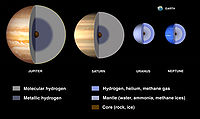
Photo from wikipedia
Abstract Radiogenic isotopic compositions of shergottite meteorites suggest that early planetary differentiation processes, which are related to the crystallization of the Martian Magma Ocean (MMO), resulted in the geochemically heterogeneous… Click to show full abstract
Abstract Radiogenic isotopic compositions of shergottite meteorites suggest that early planetary differentiation processes, which are related to the crystallization of the Martian Magma Ocean (MMO), resulted in the geochemically heterogeneous Martian mantle. In order to understand the early geochemical evolution of Mars, we investigated the Pb isotope systematics in the depleted Martian mantle on the basis of the analyses of two geochemically depleted shergottites, Dar al Gani (DaG) 476 and Yamato 980459 (Y-980459). Their initial Pb isotopic compositions were estimated from geochemical analyses of highly leached acid residues and age-correction calculations using reference crystallization ages. This yielded μ-values (238U/204Pb) for the DaG 476 and Y-980459 source reservoirs of 2.33 ± 0.07 and 2.32 ± 0.06, respectively. These μ-values are distinct from those of other depleted shergottite source reservoirs (e.g., 1.4 ± 0.1 for the Tissint meteorite) and show a negative correlation with corresponding 147Sm/144Nd, 176Lu/177Hf, ɛ182W, and e142Nd compositions. Such correlations between long- and short-lived isotopic signatures suggest that a geochemically heterogeneous depleted shergottite source mantle was formed on the early Mars. This geochemical heterogeneity would have been formed by variable mixing of depleted and enriched end-member components that originally formed by fractional crystallization in the MMO. Local remelting in the geochemically depleted Martian mantle after the crystallization of the MMO is another possible explanation for the formation of a geochemically heterogeneous depleted shergottite source mantle.
Journal Title: Geochimica et Cosmochimica Acta
Year Published: 2020
Link to full text (if available)
Share on Social Media: Sign Up to like & get
recommendations!